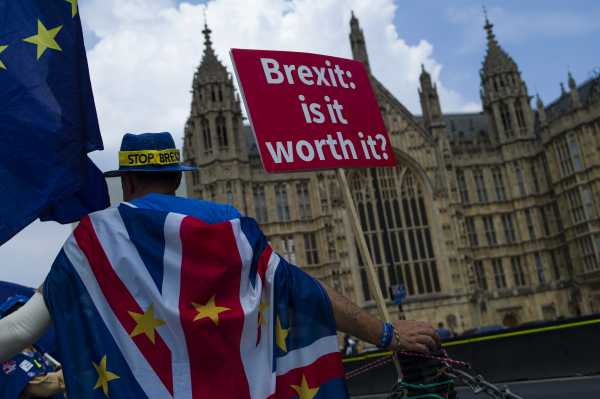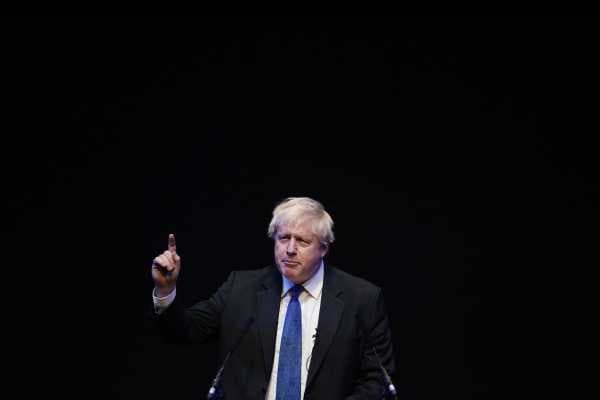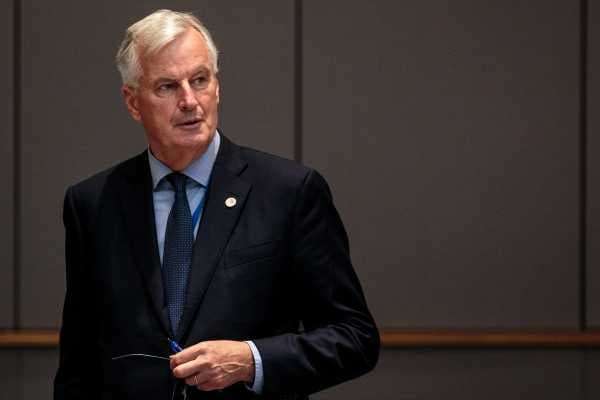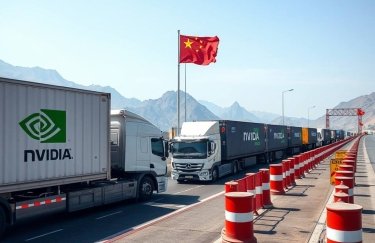
Time is running short to figure out a Brexit deal.
British Prime Minister Theresa May will meet with European Union leaders in mid-October to once again try to hash out a deal over the terms of the United Kingdom’s exit — or “Brexit” — from the EU.
The two sides have until March 29, 2019, to reach an agreement and have it ratified by the European and UK parliaments. On that date, the UK’s membership in the EU will expire, deal or no deal.
The consequences of not reaching a deal could be catastrophic — and not just for the UK: 3 million EU citizens living in the UK and 1 million Britons living in other EU countries would lose all automatic rights and protections overnight. Air travel in the UK would grind to an immediate halt. British supermarkets could run out of food. And those are just a few of the dire scenarios possible.
Both the UK and the EU want to avoid that outcome. But there are still major hurdles before they can reach an agreement — not least of which is that May’s own party is divided on what kind of deal they want with the EU.
There’s been a ton of back-and-forth for months, and it can be hard to keep track of it all, even for people who follow the issue closely. So if you’ve been wondering what the hell is going on with Brexit, you’re not alone.
That’s why we’re going to take a big step back and lay it all out clearly and concisely: how we got here, where the Brexit negotiations stand right now, what exactly the two sides are fighting over, and where things might go from here.
A quick reminder of how it all began
The UK joined the European Economic Community in 1973, which became part of the European Union when it was formed in 1993.
The EU currently has 28 European member states. As Vox’s Zack Beauchamp has explained:
These agreements bolster what are known as the four key pillars, or “four freedoms,” of the EU: freedom of movement for goods, capital, services, and people.
The UK has always had a degree of distance from the EU — it maintains its own currency, the sterling pound, and never joined the Schengen agreement, which eliminates internal border controls within the EU, though it’s still required to embrace the movement of people, including migrants, as part of those four pillars.
But in the past decade, the eurozone economic crisis and, later, the influx of refugees from Syria and other parts of Africa and the Middle East helped galvanize voters in the UK and tapped into a larger skepticism about EU membership, leading some to call for the UK to separate itself from the EU.
In 2013, then-British Prime Minister David Cameron promised to hold a referendum on whether the UK should remain in the EU or leave if his Conservative Party won elections, which it did. They held the referendum in 2016, and the “Leave” camp won by a close 52 to 48 percent vote. Cameron, who wanted to “Remain,” resigned after the referendum, and current Prime Minister Theresa May took over.
In March 2017, May formally triggered Article 50, a part of the Lisbon Treaty that governs the EU, to initiate the exit process, with the deadline set two years later: March 29, 2019. Then came the hard part of actually negotiating the exit with the EU.
The core question in these negotiations is which (if any) EU treaties and laws will continue to apply to the UK after it’s left. But while that may sound fairly simple, it’s anything but.
Key issues, as Vox’s Beauchamp explains, include:
- Whether the UK will receive any kind of free trade deal with the EU, or whether it will simply be treated like any other country, subject to the tariffs permitted by World Trade Organization rules
- Whether British financial services, a vital part of both the UK and EU economies, will be permitted to continue operating without restriction on the continent
- Whether the UK will continue to permit unrestricted migration of EU citizens (other than Croatians) into the UK, which it currently does as part of the European Economic Area, and vice versa
- What rights current EU citizens living in the UK will have to remain and continue working in the UK, and vice versa
- Whether the UK will continue to abide by the huge number of EU regulations and laws, and continue to submit to the European Court of Justice on trade disputes with EU states
These issues involve complicated considerations for both the UK and the EU. The tight timeline isn’t helping.
The two options for the UK: “soft Brexit” or “hard Brexit”

To negotiate a deal with the EU, the UK government itself first has to decide what kind of relationship it wants the country to have with the EU after the divorce.
The two competing visions for what that relationship should look like are usually referred to as “hard Brexit” and “soft Brexit.”
“Hard” Brexit
In this scenario, the UK envisions a clean break with the EU, and would then try to negotiate some sort of free trade deal with the EU. The UK gains control over things like immigration and borders, but it also loses the perks of being part of the European Union single market and customs union, which eliminate tariffs and many other trade barriers for EU member states. That arrangement would make the more hardcore anti-immigration Brexiteers happy but would also likely be incredibly disruptive to businesses and the country’s economy.
“Soft” Brexit
A “soft” Brexit involves a much less severe break with the EU. Broadly speaking, the UK would stay close to the EU and retain access to the single market and customs union. This would soften the blow to the British economy when Brexit becomes official.
The caveat, though, is that the UK would also have to abide by many of the EU laws and regulations that govern the single market and customs union. And since it would no longer be an EU member, the UK would have little or no say in what those rules are or how they’re applied.
Hard Brexiteers hate this approach because they consider it to be a Brexit in name only that would fail to restore the UK’s full sovereignty over its own affairs and leave the country at the whims of decision-makers in Brussels (where the EU headquarters are located).
May’s Conservative Party is sharply divided between those who favor a hard Brexit and those who prefer a soft Brexit. To try to solve this division, May has taken her own stab at a “soft” Brexit plan.
The Chequers plan — May’s unpopular Brexit approach
May’s proposal is called the “Chequers deal” (named for the prime minister’s country estate, where the plan came together). It involves all sorts of technical details and complicated caveats, but the basic outline is this:
- The UK stays in the European single market for goods and follows much of the existing EU rulebook.
- The UK also follows similar customs rules to those in the EU customs union but would be able to strike out on its own and make separate trade deals as well.
- The UK also gets to control its borders and who comes in and out of the country.
The hard Brexiteers in May’s party loathe the Chequers plan — to the point that members of her own government, including her foreign minister, Boris Johnson, and David Davis, the secretary who was literally in charge of negotiating Brexit, quit in protest over it in July. They see it as a “half in, half out” plan — or “EU membership-light,” as one expert called it.
But there’s another problem: Not only do influential members of her own party hate May’s Chequers plan — the European Union does too.
What the EU and the UK are stuck on

May’s Chequers plan isn’t acceptable to the EU — at all. “It looks like picking and choosing,” says Michael Leigh, a fellow at the German Marshall Fund and former EU commissioner.
May is framing her plan as a compromise: We’ll stay friends in some places and not in others. But the EU sees this as an attempt by the UK to have its cake and eat it too — to take advantage of the things it likes about being in the EU, such as zero tariffs and other trade benefits, while tossing out the EU rules it doesn’t like, such as open borders and immigration.
That’s something the EU has flat-out refused to accept “for theological and existential reasons,” Leigh says, because the EU fears it “would create a dangerous precedent and encourage other countries also to take a similar approach.”
Describing this whole situation as “theological and existential” may sound extreme, but to the EU perspective, it’s not.
The EU single market is based on four key principles: movement of goods, services, capital, and people. If the UK gets to decide what to take and what to leave, then other restive EU countries might also start rethinking their arrangements with the EU — “If the UK gets to control its borders but still gets to enjoy free trade, why can’t we get that deal, too?”
And EU leaders fear that eroding the commitment to all those principles would threaten the entire European Union experiment.
There’s another issue hanging over the EU-UK negotiations: the future of the border between Northern Ireland (which is part of the UK) and the Republican of Ireland (which is an EU member state).
And it’s an issue that’s so politically sensitive it threatens not just to upend Brexit talks, but to reignite the sectarian tensions that produced three decades of bloody conflict in Northern Ireland.
The 1998 Good Friday Agreement ended the “Troubles,” the decades-long period of sectarian violence in Northern Ireland between the Protestants, who wanted to remain with the UK, and the Catholics, who identified more closely with the Republic of Ireland.
The 1998 peace deal kept Northern Ireland as part of the UK, but it created an open border between it and the Republic of Ireland, allowing freedom of movement between the two countries.
Now, thanks to Brexit, the future of that open border — and the stability it helped create after years of horrific violence — is in question.
Both the UK and the EU want to avoid this scenario at all costs; the question is how. The EU has proposed that Northern Ireland could essentially maintain the status quo and remain in the EU customs territory and common regulatory area — which means the Republic of Ireland and Northern Ireland follow the same rules, so there’s no need for customs and border checks.
“Nope, definitely not,” was essentially the UK’s response.
May has insisted she doesn’t want a special EU status for Northern Ireland that’s separate from the rest of the United Kingdom. Her concern is that that would create basically create hard border within her own country, which would pose a threat to the UK’s sovereignty.
May’s solution is her Chequers plan, since according to that proposal, the whole of the UK would follow the EU rulebook on trade, so Northern Ireland would naturally go along. That plan sounds great — until you remember that the Chequers plan is unpalatable to the EU and to members of May’s own conservative party.
“It’s really on that issue of the status of Northern Ireland border after Brexit that the whole of the withdrawal agreement hinges,” says Katy Hayward, a professor at Queen’s College in Belfast, Northern Ireland. “Because the EU has been very clear: Unless we get that protocol agreed, then the whole withdrawal agreement collapses.”
And if that happens, it’s a no-deal Brexit. A no-deal Brexit would automatically reinstate a “hard” border between the Republic of Ireland and Northern Ireland — the exact situation both sides want to avoid.
What happens now?
May and EU leaders are meeting for a summit in mid-October. The European Union has previously called that meeting “the moment of truth” for Brexit negotiations.
This was originally seen as the last chance for the two sides to make a deal, but experts I spoke to are not overly optimistic that there will be a breakthrough — and now there’s another special summit already scheduled for November.
But progress might still be possible in October. At the Conservative Party conference last week, May didn’t explicitly refer to her Chequers plan by name when she made her pitch to the party. That has some, including Michel Barnier, the EU’s chief negotiator, reportedly thinking she might have finally realized her Chequers plan is unworkable.
Either way, the UK and EU are speeding toward the March 29, 2019, deadline. Barnier has said that the EU and UK are 80 percent agreed on a withdrawal deal that could potentially include a transition period until December 31, 2020, during which the UK would remain part of the customs union and regulatory area while the two sides work out the nitty-gritty details on the future EU-UK relationship.
If the rest of the withdrawal agreement doesn’t happen, then “the longer-term transition period where all the other details would work out wouldn’t go into place,” Spencer Boyer, a senior fellow with the Penn Biden Center for Diplomacy and Global Engagement, tells me.
Then you have a no-deal Brexit. It’s the one outcome nobody wants — and the one everyone may end up getting.
Sourse: vox.com





